Mount Ventor: a mountain that can be seen from afar
A Giant standing in the middle of Provence
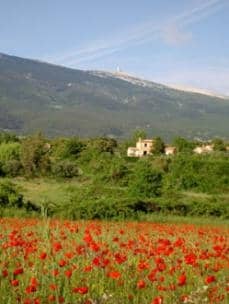
Emerging from nowhere in the middle of Provence, which it links to the Alps, culminating at 1912 metres in altitude, Mont Ventoux bears its other name of "Giant of Provence". Its name comes from the Provençal Occitan "Mont Ventor" which means "which can be seen from afar". Its old name, "Ventour", would derive from the words wind and windy, quite appropriate to the strong mistral wind that regularly blows there. Moreover, it is not for nothing that the pass situated one kilometre from the summit was called Col des tempêtes (storm pass).
Mont Ventoux extends over twenty-five kilometres from west to east and over eight kilometres from north to south. A forest of larches, cedars and firs covers it up to 1500 metres in altitude. Beyond that, the vegetation disappears to give way to an arid white summit, made of flat stone breaks called lauzes. Hence its other name, Mont Chauve (bald mountain).
Winds of over 300 km/h
Always check the weather forecast before venturing up the slopes of the Géant. Gusts of wind can sometimes blow violently and destabilise the cyclist. The site is known for its strong gales, up to 300 km/h. The last record was 320 km/h observed in 1967. Cycling goggles are essential to protect you from the windblown sand.
« Les épreuves que tu as endurées tant de fois, aujourd'hui, dans l'ascension de cette montagne, sache bien que tu les rencontres aussi, toi-même comme tant d'autres, dans la recherche du bonheur... nombre d'escarpements coupent cette route et fait avancer de vertu en vertu, par des degrés éminents. Sur le sommet et le but suprême, le terme de la route vers lequel tend notre voyage. »
Pétrarque, « L'ascension du Mont Ventoux », 1336
Climbing the Ventoux by bike, a real challenge
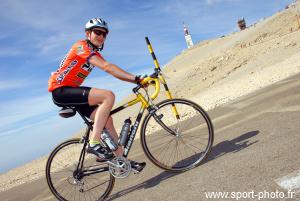
The ascent by bike can be done from Bédoin, Sault or Malaucène. The ascent from Bédoin is by far the most difficult, also the most famous. Mont Ventoux is a difficult summit because of its slope but also because of the aridity of its summit which exposes the cyclist to the sun in summer, to the harsh cold in winter and to the sometimes very violent winds, thus making it very often unfriendly. The Géant is not easily tamed. The experienced cyclist will ride it after serious preparation and should never underestimate the difficulty of its slopes and its very changeable and often aggressive climate. See our photo reports and descriptions of Mont Ventoux bike climb.
" Stranger who for the first time dares to tread the slopes of the Giant, come humble and armed with courage for thou shalt need it greatly. And if you have the slightest doubt, then go your way and forget forever your foolish project... "
P. Baudoin
Mont Ventoux's reputation for its bike climbs has crossed the planet and many foreign cyclists come every year to challenge the Giant of Provence. The most addicted climb it several times a year or join the cinglés du Ventoux club, a brotherhood affiliated to the FFCT whose objective is to climb Mont Ventoux 3 times in the same day, from Bédoin, Malaucène and Sault. There were more than 9000 members in 2016, including 550 women, aged from 10 to 86 years old! To spice up the event, there is a fourth route, a forest trail that can be climbed on a mountain bike and allows you to obtain the title of "galerian". And if that is not enough, the strongest can try to enter the circle of the restricted bicylists by doubling each of the 3 climbs.
Mont Ventoux and the Tour de France
Mont Ventoux is a regular feature of the Tour de France. The Grand Boucle climbed it for the first time in its history in 1951. That year, Frenchman Lucien Lazarides crossed the summit first in the Montpellier-Avignon stage, a race won by Louison Bobet. The climb was classified as hors catégorie in 1987. In 70 years (1951-2021), the Tour will have climbed it 18 times, including 9 summit finishes, 8 of which were via Bédoin, the most difficult slope.
9 stage finishes at the summit
It was in 1958 that a stage of the Tour arrived for the first time at the summit of the Géant. It was a time trial from Bédoin to Mont Ventoux where Charly Gaul won the stage with a time of 1 hour 2 minutes and 9 seconds.
In 1965, it was Raymond Poulidor's turn to conquer the summit. He changed his bike during the race, opting for an ultra-light bike.
In 1970, Eddy Merckx was the first rider to win the Ventoux in yellow, a record that remained unbroken until the 2013 Tour. Exhausted, the Belgian suffered a slight illness which, he later said, was a tactic to escape the journalists and get back to his hotel faster!
In 1972, Bernard Thévenet won just ahead of Merckx in a climb from Malaucène.
In 1987, the Frenchman Jean-François Bernard won the second time trial in the history of the Tour organised on Mont Ventoux.
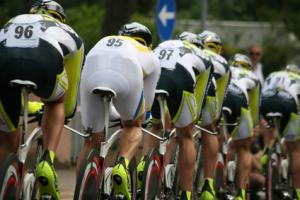
Marco Pantani, in 2000, wins the stage. After a long climb, the Italian attacked in the last kilometres, but was quickly caught by Armstrong. The latter let him cross the finish line first.
Richard Virenque is the next rider to have his name inscribed on the slopes of Mont Chauve. A lead of nearly 8 minutes over the peloton allowed him to win the Lodève - Mont Ventoux stage in 2002. Lance Armstrong, who was chasing him, tried to catch him but only arrived in third place 2 minutes 20 seconds behind.
In 2009, Juan Manuel Gárate was the first Spaniard to win on Mont Ventoux.
Finally, on 14 July 2013, Christopher Froome dominated the Giant in a gruelling 242-kilometre stage from Givors to Mont Ventoux. The British rider, whose team-mates were all gradually finding themselves in difficulty, pulled off a spectacular coup at the Chalet Reynard, dropping Alberto Contador, who was in his wheel at the time, with a spectacular acceleration from the front. Nothing stopped him until the summit. He is the first Briton to win on the Ventoux.
A formidable summit
The heat that often reigns on the slopes of the Ventoux in summer when the Tour passes through, the difficulty of its slope and the fact that its ascent is placed at the end of generally long stages make the Mont Ventoux a formidable challenge. It is not for nothing that it is nicknamed by specialists the "cauldron of hell" or "cauldron of witches". The Giant makes the most ambitious modest. Many cycling champions have been able to dominate it, but others have lost their illusions or even their lives, such as the British rider Tom Simpson, who suffered a heart attack during the 1967 Tour de France.
23 km/h average speed from Bédoin!
The current record for cycling up Mont Ventoux via Bédoin was set in 2004 by Iban Mayo Diez during the Critérium du Dauphiné Libéré. The Spaniard reached the summit in 55 minutes and 51 seconds during a Bédoin-Mont Ventoux time trial, an average speed of 23.2 km/h! Hamilton, Sevilla, Mercado and Lance Armstrong were just behind with times between 36 seconds and 1 minute 57 seconds faster.
Cycling itineraries
It is by far the most difficult, the most famous too. It's 21 kilometres of climbing, 1600 metres of vertical drop, an average gradient of 7.5% (8.9% from the St Estève bend), slopes of up to 11.5% and almost no opportunity for respite.
The ascent of Mont Ventoux from Malaucène
While the ascent of Mont Ventoux from Malaucène is less famous than the one from Bédoin, it is nonetheless very difficult with 21 kilometres of irregular ascent, 1535 metres of vertical drop, and passages exceeding 12% gradient.
The ascent of Mont Ventoux from Sault
Climbing Mont Ventoux via Sault is unequivocally the "easiest" of the three sides. It's still nearly 26 kilometres of road to "swallow" at an average gradient of 4.6% for a vertical drop of 1186 metres.
Photos, profiles, pass condition
Bedoin

Bédoin is a pretty little farming village at the foot of Mont Ventoux. The village officially has 3,110 inhabitants (2013 figures) but its population increases fivefold in summer due to tourism. This is without counting the exceptional events such as the Dauphiné Libéré race or the Tour de France which, in 2009, gathered 500,000 people on the slopes of Mont Chauve. It must be said that Bédoin is a strategic site. As the starting point of the South side cycling climb, the most famous route, also the most arduous, the village attracts many cyclists and hikers who have come to face the formidable slopes of the Géant. Bédoin is also appreciated for its sunny climate and its calm.
The commune is home to the largest communal forest in France (6,300 ha, i.e. 2/3 of its surface area). A legacy of antiquity, the vineyards are also very present in the area, covering more than 800 ha and benefiting from a very sunny climate. Bédoin produces a popular wine (Côtes du Ventoux appellation contrôlée and vin de pays) and has a cooperative cellar. In addition to tourism and wine, the commune also lives from agriculture (fruit, asparagus, olive oil). Fruit production, especially cherries, is the third largest source of income after tourism and wine.

The region is of course famous for cycling and mountain biking (marked circuits) but also attracts tourism for its hill-climbing, hiking and horse riding and skiing at the Mont Serein resort.
To see : the Romanesque chapel Notre Dame du Moustier. The Church of Les Baux de Bédoin. The Chapel of the Madeleine (12th century). The Church of Saint-Pierre (16th century), erected at the beginning of the 18th century and dedicated to Saint-Pierre. It was partially destroyed in 1794 and rebuilt at the beginning of the following century. It dominates the village. Don't miss a sunrise from the top of the Ventoux.
Malaucène
An ancient fortified town of which only a few gates and a fort have survived to this day, the capital of the Ventoux, Malaucène is a charming little Provençal village of 2,758 inhabitants (2013 figures). The town is known for having been the summer residence of Pope Clement V, a monastery built in the 12th century, of which only a chapel remains today. He spent many stays there between 1309 and 1313. In 1309, Clement V had the church of Saint-Michel-Saint-Pierre built. The building was built on the site of a former temple.
Malaucène was for a long time an industrial town. For more than 4 centuries, the town was famous for its paper mills specialising in the manufacture of cuff paper used in cigarette filters. The last factory was closed in 2009.
Today, the town lives from agriculture and tourism. In particular, it produces the famous "white cherries", "burlat" and "cœur de pigeon" of the Ventoux. Its position at the foot of the slopes of Mont Chauve makes it a favourite resort for hiking, horse riding, cycling and, in winter, skiing and snowshoeing.
The Gothic church with its remains of fortifications, its carved pulpit and its historic organ. The houses and ramparts of the old town. The Clock Tower (1539). The Groseau Chapel (12th century).
Sault

The village of Sault, at the foot of the Giant of Provence
Sault is a village of 1360 inhabitants (2013 figures) located in the Vaucluse, east of Mont Ventoux. Perched on a rocky outcrop, at an altitude of 765 metres, it dominates the Nesque valley.
Famous throughout the world for its lavender cultivation, the village lives from agricultural production (lavender, lavandin, honey, spelt) and livestock farming (pigs, sheep). The "Porc du Ventoux" is a quality label for pig breeders in the region.
In Sault, don't miss the signposted tour "1 hour in the footsteps of the wolf" which will take you through the narrow streets of the old fortified village. You will discover the ramparts of the old castle and its entrance gates as well as houses dating from the medieval period.
On the Place de l'Eglise, the church of Notre Dame de la Tour is a listed building. This 12th century building has a Romanesque nave and a 16th century sanctuary consisting of 3 chapels.
Finally, the municipal museum founded in 1859 welcomes you in July and August. It exhibits paintings and various objects.
Ces articles peuvent aussi vous intéresser
Comment préparer l'ascension à vélo d'un col difficile
Alimentation du sportif : quels glucides consommer quand on fait du sport ?
Les meilleurs compteurs-GPS de vélo et VTT en 2025
Les étirements : faut-il encore les pratiquer ?
Comment préparer une boisson isotonique de l'effort ?
Le Petit Guide Pratique du Sportif Amateur
Une synthèse des meilleurs astuces et conseils pour gagner en performance et vous faire davantage plaisir dans votre activité d'endurance. Prix : 0,00 € (port 0,00 € pour la France)
« Ce guide est GENIAL ! » (Dominique A)
« Petit bouquin génial moi qui suis entraineur. » (Laurent P)
Le Guide du Home Trainer (applicable aussi au spinning)
Conseils, plans d'entraînement, plus de 40 exercices variés et motivants, des tests pour évaluer vos progrès. Prix : 0,00 € (port 0,00 € pour la France)
« Ce petit livre est FANTASTIQUE ! » (Alain L)
« Félicitations pour votre guide : après 1 an d'utilisation, des progrès fabuleux en compét et un 1er PODIUM. » (Laurent J)
Crédit photos : Adobe Stock. Cet article contient des liens commerciaux.



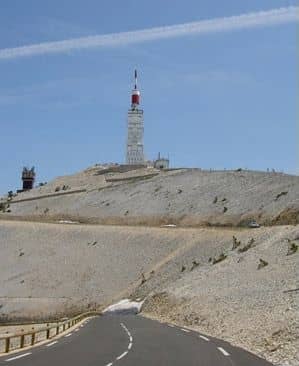
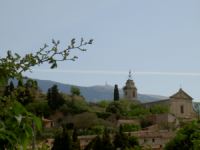
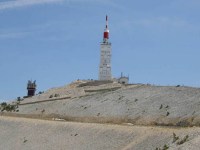
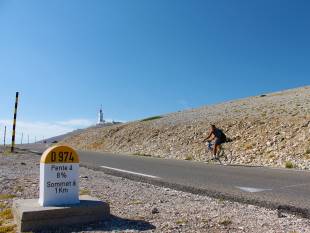

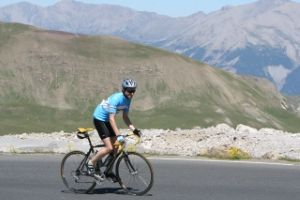

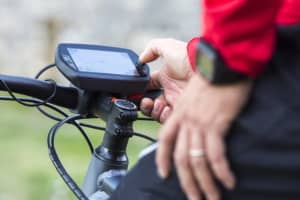



 Une synthèse des meilleurs astuces et conseils pour gagner en performance et vous faire davantage plaisir dans votre activité d'endurance. Prix : 0,00 € (port 0,00 € pour la France)
Une synthèse des meilleurs astuces et conseils pour gagner en performance et vous faire davantage plaisir dans votre activité d'endurance. Prix : 0,00 € (port 0,00 € pour la France) Conseils, plans d'entraînement, plus de 40 exercices variés et motivants, des tests pour évaluer vos progrès. Prix : 0,00 € (port 0,00 € pour la France)
Conseils, plans d'entraînement, plus de 40 exercices variés et motivants, des tests pour évaluer vos progrès. Prix : 0,00 € (port 0,00 € pour la France)